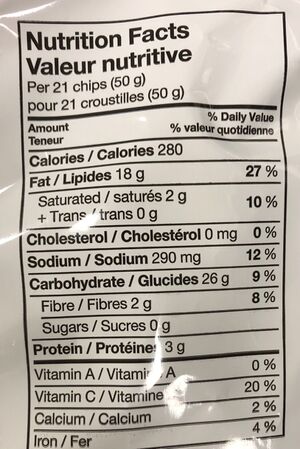Course:FNH200/Assignments/2021/Ruffles Vs. Lays Baked
Introduction
Frito-Lay is a popular potato chip company originating in the United States, known distinctively for their popular chip brands, including Ruffles, Lays, and Cheetos amongst many others. Due to various health concerns associated with chips, including high sodium and fat content, low nutrient content, and high calories, they have been condemned as an unhealthy snack, despite their popularity[1]. With that said, Baked Lays are regarded as a healthier alternative to the traditional deep fried potato chips, which will be represented by Ruffles Original Potato Chips. We will explore whether the baked alternative offers more health benefits through an analysis of the ingredients, and possible additives and/or fat and sugar substitutes in each product.
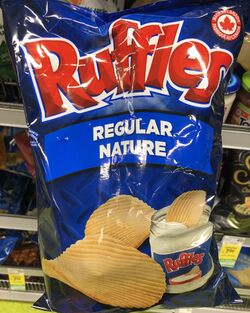
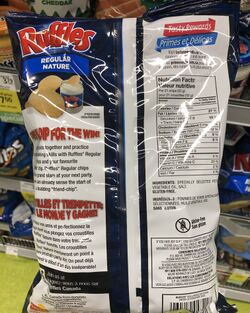
Ingredient Lists
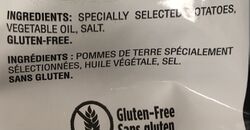
| Ruffles Original Potato Chips | Lay’s Original Baked Potato Chips |
|---|---|
| Potatoes | Dehydrated Potato Flakes (Mono- and Diglycerides, Sodium Phosphate, Citric Acid, Dextrose) |
| Vegetable Oil (Sunflower, Corn, and/or Canola Oil) | Corn Starch |
| Salt | Vegetable Oil |
| Sugar | |
| Salt | |
| Soy Lecithin | |
| Colour |
| Fat Substitutes | Sugar Substitutes | Additives | |
| Ruffles Original Potato Chips | None | None | None |
| Lay’s Original Baked Potato Chips | None | None | - Citric Acid
- Soy Lecithin - Dextrose - Sodium Phosphate - Mono- and Diglycerides - Colour |
Comparison
Lays Baked Original Potato Chips contain all three of the ingredients that make up Ruffles Original Potato chips (Potatoes, Salt and Vegetable Oil) and four more. The difference in these three ingredients is that the non-baked product does not use dried (dehydrated) potatoes which are used in the Baked product. Another difference between these ingredient lists is that there are two ingredients providing sweetness in the Baked chips (Sugar and Dextrose) and none in the Original. Finally the Baked version has additives (Citric Acid, Soy Lecithin, Dextrose, Sodium Phosphate, Mono- and Diglycerides, and Colour) which are not in the original product.
Function
Corn Starch is used in the food industry to coat the food and help absorb oil. In the context of the Baked Lays, this helps the baked chip become crispier[2] to help replicate the crunch of a fried potato chip. Corn starch tends to gelatinize when combined with liquids, so it is often used as a thickening agent[3]. The gelatinization can be prevented with the addition of sugar[3].
Soy Lecithin is used as an emulsifier[4]in food preparation. This means it helps blend and mix ingredients together. In the Baked Lays, the chip is created from a dry ingredient base that is mixed with oil. Therefore, an emulsifier would help in ensuring even mixing, resulting in a chip that is appealing physically and uniform in taste. Lecithin has also been shown to aid in extending the shelf life[5], which is beneficial for a product like potato chips.
Salt is used for a multitude of reasons. In the case of the Ruffles and Lays, a prominent role is to provide flavor[3]. It also aids in preventing bacterial growth[3] which also helps extend the shelf life of the Baked Lays. Salt’s ability to help with browning during baking[3] is also beneficial as it allows for a more appetizing looking potato chip.
Dextrose is used as a sweetener[3] which can aid in overall taste of the chip. Similarly to some of the previous additives, it can also help with preservation of the product[6].
Sodium Phosphate is used in processed foods as an emulsifier, a thickener, and/or a leavening agent[7]. In the case of the Baked Lays, sodium phosphate is added to the dehydrated potatoes in order to stabilize the texture of the potato flakes, and to extend its shelf life by balancing the pH levels in the flakes[7].
Mono- and Diglycerides of fatty acids are added to processed foods as emulsifiers[8]. In the context of the Baked chips, they are also used in the Dehydrated Potato Flakes to extend their shelf life, and add to the flavour and texture of the potatoes.
Citric Acid is used as a class IV food preservative[9] that can be added to fats and oils, and mono- and diglycerides (as in the Baked Lays). In the Lays, citric acid is also used as a flavour enhancer in the Potato Flakes, and to balance the acidity, along with the sodium phosphate.
Colour refers to coloring agents[10]. In the case of the Baked Lays, it helps replicate the colour of a fried chip and looks more alluring to eat. These extracts have also been shown to prevent microbial growth[11].
Labels
Using the Government of Canada’s Food Labelling Requirements Checklist, the following has been determined:
The products above meet the Food and Drugs Act of Canada’s regulations. No harmful substances are present. Both products' labels include a list of ingredients, a nutritional facts table, bilingual labelling, country of origin, a statement of serving size, quantity of the product, best before dates, and storage instructions - all of which are required for compliance with the necessary labelling requirements. The location of the labelling on both products is appropriate as well as the information presented with it (e.g. the ingredient or allergen list). Both are clearly legible and will likely not be disrupted when the product is opened.
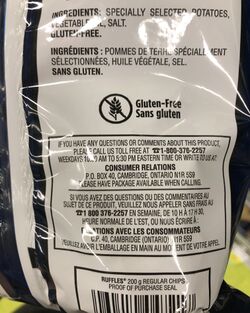
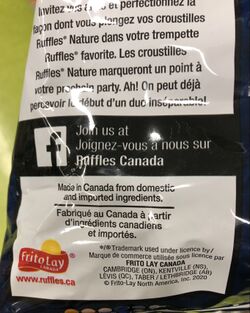
References
- ↑ Lama, Siddhi Camila (May 19, 2021). "The Calories in Potato Chips, and 5 Reasons They're Unhealthy". Livestrong. Retrieved July 19, 2021.
- ↑ Altunakar, Bilge. "Functionality of batters containing different starch types for deep-fat frying of chicken nuggets". European Food Research and Technology. 218: 318–322.
- ↑ 3.0 3.1 3.2 3.3 3.4 3.5 The BC Cook Articulation Committee (2015). Understanding Ingredients for the Canadian Baker. BCcampus. ISBN 978-1-7753524-5-7.
- ↑ Van Nieuwenhuyzen, W. "Lecithin Production and Properties". Journal of the American Oil Chemists' Society. 53: 425–427.
- ↑ Lee, Mathew. "What Is the Purpose of Lecithin?".
- ↑ Galic, Bojana. "What Is Dextrose and Why Is It in Our Food?".
- ↑ 7.0 7.1 Whelan, Corey (September 18, 2018). "Sodium Phosphate". Healthline. Retrieved July 19, 2021.
- ↑ Huizen, Jennifer (May 25, 2018). "What are monoglycerides and are they safe?". MedicalNewsToday. Retrieved July 19, 2021.
- ↑ Government of Canada. "Food and Drug Regulations (C.R.C., c. 870)".
- ↑ Government of Canada. "Food and Drug Regulations (C.R.C., c. 870)".
- ↑ Irobi, O N. "Antimicrobial Activity of Annatto (Bixa orellana) Extract". International Journal of Pharmacognosy. 34: 87–90.
| This Food Science resource was created by Course:FNH200. |
